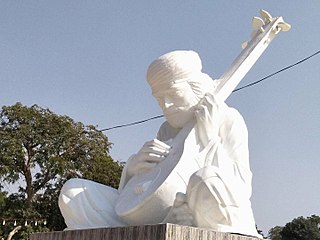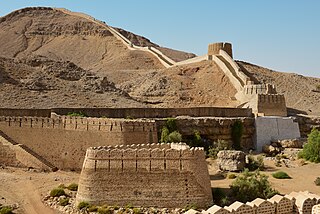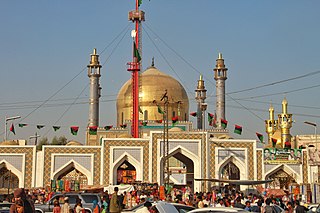
Thatta is a city in the Pakistani province of Sindh. Thatta was the medieval capital of Sindh, and served as the seat of power for three successive dynasties. Thatta's historic significance has yielded several monuments in and around the city. Thatta's Makli Necropolis, a UNESCO World Heritage Site, is site of one of the world's largest cemeteries and has numerous monumental tombs built between the 14th and 18th centuries designed in a syncretic funerary style characteristic of lower Sindh. The city's 17th century Shah Jahan Mosque is richly embellished with decorative tiles, and is considered to have the most elaborate display of tile work in the South Asia.

Shah Abdul Latif Bhittai, commonly known by the honorifics Lakhino Latif, Latif Ghot, Bhittai, and Bhit Jo Shah, was a Sindhi Sufi mystic and poet from Pakistan, widely considered to be the greatest poet of the Sindhi language.
Muslim Rajputs or Musalman Rajpoots are the descendants of Rajputs in the northern regions of the Indian subcontinent who generally are followers of Islam. Reportedly, they converted from Hinduism to Islam from the medieval period onwards, creating various dynasties and states while retaining Hindu surnames such as Chauhan. Today, Muslim Rajputs can be found mostly in present-day Northern India and Pakistan. They are further divided into different clans.
The Samma dynasty was a medieval Sindhi dynasty which ruled the Sindh Sultanate from 1351 before being replaced by the Arghun dynasty in 1524.
The Arghun dynasty ruled over the area adjoining Southern Afghanistan and then the Sindh Sultanate from the late 15th century to the early 16th century. Arghun rule can be divided into two branches: the Arghun branch of Dhu'l-Nun Beg Arghun that ruled until 1554, and the Tarkhan branch of Muhammad Isa Tarkhan that ruled until 1593.
Badin is the main city and capital of Badin District in Sindh, Pakistan. It lies east of the Indus River. It is the 87th largest city in Pakistan. Badin is often called 'Sugar State' due to its production of sugar.

Thatta District is located in the southern area, locally called Laar, of the province of Sindh, Pakistan. Its capital is Thatta. It is home to a large necropolis of Makli. In 2013, several talukas were separated to form the new Sujawal District.

Jamshoro District, is a district of Sindh province, Pakistan. Jamshoro city is the capital while Kotri is the largest city of the Jamshoro District. The district borders Dadu district to the north. To the east, the Indus separates it from Shaheed Benazirabad, Matiari and Hyderabad districts. Thatta district lies to the south, and Karachi district to the south west. To the west, the Kheerthar Range separates it from the Sindh and Hub district of Baluchistan.

Makli Necropolis is one of the largest funerary sites in the world, spread over an area of 10 kilometres near the city of Thatta, in the Pakistani province of Sindh. The site houses approximately 500,000 to 1 million tombs built over the course of a 400-year period. Makli Necropolis features several large funerary monuments belonging to royalty, various Sufi saints, and esteemed scholars. The site was inscribed as a UNESCO World Heritage Site in 1981 as an "outstanding testament" to Sindhi civilization between the 14th and 18th centuries.

Uthman Marwandi, popularly known as Lal Shahbaz Qalandar, was a Sufi saint and poet who is revered in South Asia.
Sindhi literature is the collection of oral and written literature in the Sindhi language in prose and poetry. The Sindhi language of the province of Sindh in Pakistan is considered one of the oldest languages of ancient India, and influenced the language of Indus Valley inhabitants. Sindhi literature has developed over a thousand years.

Bukkur, Bakhar or Bhakkar is a historical city and an Island fort situated between Rohri and Sukkur in the Sindh province of Pakistan. Bhakkar is also known as "Old Sukkur".
Paat, also known as Pat or Goth Pat, is a small town in the Dadu District of Sindh, Pakistan. It is located at 20°28'0N 48°68'0E with an altitude of 25 metres (82 ft). As of 2017, it has a population of 9,507, in 1,707 households. It is the seat of a tapa.
Jam Khairuddin Tamachi bin Jam Unar was the third Sultan of Sindh from the Samma dynasty reigning first from 1367 to 1371 and then from 1389 to 1392.
Nasir al-Din Abu al-Fatah Firuz Shah II, commonly known as Jam Feroz (1508–1524/5), was the last ruler of the Samma dynasty of Sindh. Jam Feroz proved himself a weak ruler and lost his kingdom to Arguns, thus Sindh came under foreign rulers.
Mubarak Khan Lashari also known as Darya Khan Lashari , was a famous general of Samma Dynasty of Sindh, a powerful statesman and regent at the court of Samma ruler Jam Feroz.
Unarpur is a village and deh in Manjhand taluka of Jamshoro District, Sindh. It is located close to the west bank of the Indus river, across from Matiari, on the main road from Kotri to Sehwan. As of 2017, Unarpur has a population of 4,092, in 891 households. It is the seat of a tappedar circle, which also includes the villages of Belo Unerpur, Budhapur, Nai Jetharo, and Wachero.
Kakrala was a historical region in southern Sindh, in the coastal parts of the Indus Delta. Descriptions of its precise extent vary, but it lay in the middle part of the delta, comprising the present-day taluqas of Shahbandar and Jati in Sujawal and Thatta districts. It has been described as the region from Jati to Kharo Chan, or the region between the mouths of the Wanyani and Pitti rivers. This area later formed part of the pargana of Ghorabari.

Mirza Jani Beg Tarkhan was the last Sultan of Sindh. He succeeded his grandfather Mirza Muhammad Baqi after his death. He ruled from 1585 to 1591 as an independent monarch of Sindh but was forced to submit to Mughal authority. He later involuntarily abdicated in 1593 and a Mughal Subahdar was appointed in his place. But due to social and public unrest, the Mughal authority appointed Jani in his place in 1594. Jani continued to serve as the Mughal Subahdar till his death in 1601.








